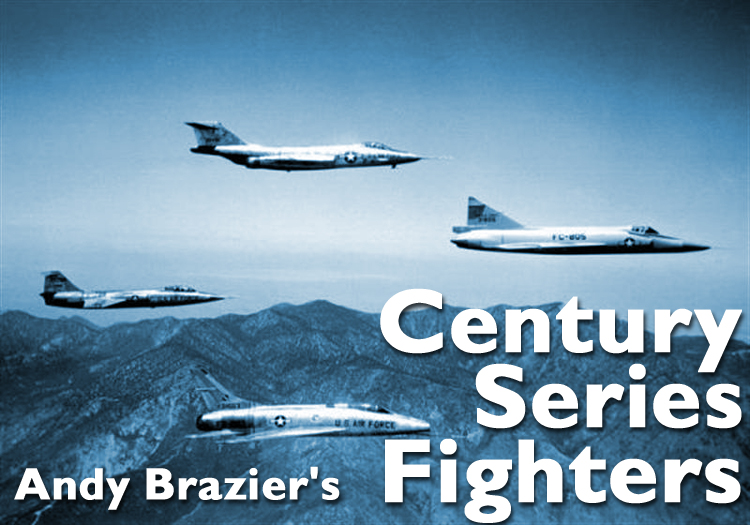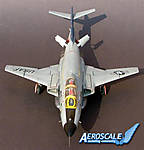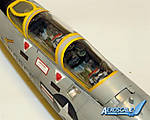1⁄35Century Series Fighters Pt. 2
1
Comment

The jet age is epitomized by the legendary Century series of fighters.
The Century series aircraft, were tasked with defending the American homeland from the Soviet forces at the height of the Cold War, fighting a tenacious enemy over Vietnam and were also the backbone of NATO's nuclear strike force.
They have been used as interceptors, bombers, reconnaissance and in nearly every conceivable role in between.
F-101 Voodoo
The McDonnell F-101 Voodoo was a supersonic designed to escort heavy bombers and serve as a fighter bomber, an all-weather interceptor and a photo reconnaissance aircraft. It served during the Cuban missile crisis and during the Vietnam war. It was nicknamed "the long bird" on occasion.The Voodoo evoked superlatives. It was bigger, faster and pilots who took the RF-101C to Hanoi flew higher and faster then anything around them, challenged air defense systems, and succeeded at high risk daytime reconnaissance missions. Crew chiefs who worked on the aircraft in the Arctic winds cursed the plane for being nearly impossible to work on, but became excited when both afterburners were lit and the Voodoo was hurtling skywards on another intercept mission. The Voodoo was arguably the most difficult, dangerous to fly aircraft to ever enter Squadron service. From the beginning of its career to the end the F-101 had the reputation of forgiving no one, ever.
It began as the XF-88 all-weather interceptor, which first flew at Muroc Dry Lake Air base in 1948. The original mission for the XF-88 was to escort the Convair Convair B-36 Peacemaker bomber. The two XF-88 prototypes evolved into the F-101 Voodoo. The Voodoo was the first production airplane capable of reaching 1000 mph (1609 km/h) in level flight.
The Voodoo was famous for its staggering twin engine afterburners, but unfortunately it was not without faults. During its entire career it had a tendency to suddenly do a nose pitch-up because of the way air flowed over the low wing and its high tail. Quite a few of the Voodoos lost in accidents on take-off and landings were due to this. The Voodoo also lacked a zero-zero ejection seat, a seat allowing you the comfort of ejection (and survival) from zero height and zero speed. In order to eject you had to be above 900 feet, and at least one pilot was lost because of this shortcoming.
McDonnell delivered 807 F-101 Voodoos, designed as long-range, twin engined jet fighters to escort bombers, attack distant targets and provide close air support for ground troops. Attack fighter, interceptor and reconnaissance versions served with the U.S. Strategic Air Defense and Tactical Air Commands and in Canada. The multi-mission F-101 Voodoo was used by all three U.S. Air Force Commands - Strategic, Tactical and Air Defense. The Voodoo flew the fastest combat missions ever flown (with the exception of the SR-71 Blackbird) during recce runs over North Vietnam.
Voodoo variants:
XF-88, penetration fighter prototype. 1 built.XF-88A, penetration fighter with afterburner. 1 built
XF-88B, turboprop testbed. 1 converted
F-101A, strategic fighter. 77 built
JF-101A, developmental test aircraft. 7 converted
YRF101-A, reconnaissance prototype. 2 built
RF-101A, reconnaissance aircraft. 35 built
F-101B, two-seat, long-range interceptor. 479 built
CF-101B, Canadian interceptor. 112 transferred
JF-101B, developmental aircraft. 1 converted
NF-101B, developmental aircraft. 1 built, 1 converted
RF-101B, reconnaissance conversion of RF-101A. 23 converted
TF-101B, dual-control training aircraft. More than 72 converted or built
EF-101B, Canadian ECM aircraft. 1 transferred
F-101C, upgraded F-101A strategic fighter. 39 built
F-101F/TF-101F, Initially interceptor, later dual-control training aircraft. More than 72 built or converted
CF-101F, Canadian dual-control training aircraft. 20 transferred
RF-101C, reconnaissance aircraft. 166 built RF-101G, reconnaissance conversion of F-101A. 27 converted
RF-101H, reconnaissance conversion of F-101C. 32 converted
Performance (F101B)
Maximum speed: 1.72 (1,134 mph, 1,825 km/h) at 35,000 ft (10,500 m)Range: 1,520 mi (1,320 nm, 2,450 km)
Service ceiling: 58,400 ft (17,800 m)
Rate of climb: 49,200 ft/min (250 m/s)
Wing loading: 124 lb/ft² (607 kg/m²)
Thrust/weight: 0.74
Armament
Missiles: 4x AIM-4 Falcon IR missiles2x Air-2 Genie nuclear rockets
or 6x AIM-4 Falcon IR missiles
Model
1/48 Monogram F-101 Voodoo, Built out of the box. Xtracrylix acrylics used for the ADC Grey and wheelwells. Tamiya acrylics used for the tail, red areas and canopy. Markings are for 87 TH FIS, Lockbourne AFB, Ohio.Comments
Wow! What a beautiful jet. Makes me want to get back into jets; currently stuck in the mode of WW2 aircraft. What scale is it?
I also did not realize the 101 was such an unforgiving aircraft to fly. Interesting. Take care. Russell
MAY 12, 2007 - 10:35 PM
Copyright ©2021 by Andy Brazier. Images also by copyright holder unless otherwise noted. The views and opinions expressed herein are solely the views and opinions of the authors and/or contributors to this Web site and do not necessarily represent the views and/or opinions of AeroScale, KitMaker Network, or Silver Star Enterrpises. Images also by copyright holder unless otherwise noted. Opinions expressed are those of the author(s) and not necessarily those of AeroScale. All rights reserved. Originally published on: 2007-05-13 00:00:00. Unique Reads: 17171






















